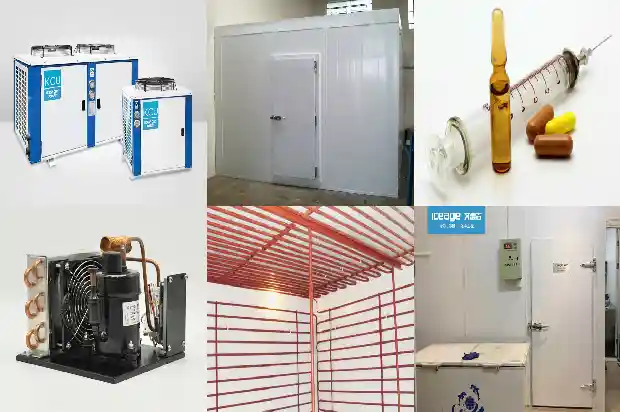How Do Pressure and Temperature Affect the Refrigeration System?
2025-03-11
I. Detection of Pressure and Temperature in the Refrigeration System
The Concept of Pressure in the Refrigeration System: When the refrigeration system is in operation, it can be divided into two parts: high pressure and low pressure. The high-pressure section ranges from the exhaust port of the compressor to the front of the throttle valve, and this section is called the exhaust pressure. The pressure at the suction port of the compressor is called the suction pressure, and the suction pressure is close to the evaporation pressure.
The Concept of Pressure in the Refrigeration System: When the refrigeration system is in operation, it can be divided into two parts: high pressure and low pressure. The high-pressure section ranges from the exhaust port of the compressor to the front of the throttle valve, and this section is called the exhaust pressure. The pressure at the suction port of the compressor is called the suction pressure, and the suction pressure is close to the evaporation pressure.
- Evaporation Temperature:
It refers to the temperature at which the liquid refrigerant boils and vaporizes in the evaporator. For example, the te of an air conditioning unit. An evaporation temperature of 5 to 7 degrees is considered the optimal evaporation temperature for an air conditioning unit, that is to say, the designed te of the air conditioning unit is between 5 and 7 degrees. When the air conditioning unit after maintenance is being debugged, if the te does not reach the range of 5 to 7 degrees, the expansion valve should be adjusted rapidly, and the suction pressure of the compressor should be detected. The purpose is to understand the evaporation temperature during the operation of the unit. Since the te cannot be directly detected, the evaporation temperature can only be obtained by detecting the corresponding evaporation pressure (by referring to the thermodynamic property table of the refrigerant). - Condensation Temperature:
It is the temperature at which the superheated vapor of the refrigerant condenses into a liquid after releasing heat in the condenser. The condensation temperature cannot be directly detected either. It can only be obtained by detecting the corresponding condensing pressure and then referring to the thermodynamic property table of the refrigerant. When the condensation temperature is high, the condensing pressure rises correspondingly, and they correspond to each other. If the condensation temperature is extremely high, the load of the unit is heavy, the motor is overloaded, which is not conducive to operation. The refrigeration capacity decreases correspondingly, and the power consumption increases, which should be avoided as much as possible. - Discharge Temperature:
It refers to the temperature at the exhaust port of the compressor (including the temperature of the exhaust port connecting pipe). A temperature measuring device is necessary to detect the discharge temperature. Generally, small units do not have such a device. For temporary measurement, a semiconductor point thermometer can be used, but the error is relatively large. The discharge temperature is affected by the suction temperature and the condensation temperature. If the suction temperature or the condensation temperature rises, the discharge temperature will also rise correspondingly. Therefore, to stabilize the discharge temperature, the suction temperature and the condensation temperature need to be controlled. - Suction Temperature:
It refers to the gas temperature of the suction connecting pipe of the compressor. A temperature measuring device is required to detect the suction temperature. Generally, small units do not have a temperature measuring device. During maintenance and debugging, it is usually estimated by touching with the hand. For an air conditioning unit, the suction temperature is generally required to be controlled at about ts = 15 degrees. Exceeding this value will have a certain impact on the refrigeration effect.
II. The Influence of the Change of Suction Pressure on the Refrigeration System
The suction pressure is closely related to the evaporation temperature and the flow rate of the refrigerant. For a system using an expansion valve, the suction pressure is related to the opening degree of the expansion valve, the refrigerant charging amount, the cooling efficiency of the compressor, and the load size.
The suction pressure is closely related to the evaporation temperature and the flow rate of the refrigerant. For a system using an expansion valve, the suction pressure is related to the opening degree of the expansion valve, the refrigerant charging amount, the cooling efficiency of the compressor, and the load size.
- Low Suction Pressure:
When the suction pressure is lower than the normal value, the factors include insufficient refrigeration capacity, small cooling load, small opening of the expansion valve, low condensing pressure (for the capillary tube system), and an unsmooth filter. - High Suction Pressure:
When the suction pressure is higher than the normal value, the factors include excessive refrigerant, large refrigeration load, large opening degree of the expansion valve, high condensing pressure (capillary tube system), and poor compressor efficiency, etc.
III. The Influence of the Change of Discharge Pressure on the Refrigeration System
When the refrigeration system is in operation, its discharge pressure corresponds to the condensation temperature, and the condensation temperature is related to the flow rate and temperature of the cooling medium, the refrigerant inflow amount, the cooling load, etc. When checking the refrigeration system, a discharge pressure gauge should be installed at the exhaust pipe to detect the discharge pressure, which can be used as data for analyzing faults.
When the refrigeration system is in operation, its discharge pressure corresponds to the condensation temperature, and the condensation temperature is related to the flow rate and temperature of the cooling medium, the refrigerant inflow amount, the cooling load, etc. When checking the refrigeration system, a discharge pressure gauge should be installed at the exhaust pipe to detect the discharge pressure, which can be used as data for analyzing faults.
- High Discharge Pressure:
When the discharge pressure is higher than the normal value, generally, there are situations such as small flow rate of the cooling medium or high temperature of the cooling medium, excessive refrigerant charging amount, large cooling load, and large opening of the expansion valve.
The above factors will cause an increase in the circulating flow rate of the system, and the condensing heat load will also increase correspondingly. Since the heat cannot be dissipated completely in time, the condensation temperature rises, and what can be detected is the rise of the exhaust (condensing) pressure. In the case of low flow rate of the cooling medium or high temperature of the cooling medium, the heat dissipation efficiency of the condenser decreases, resulting in an increase in the condensation temperature.
In the case of low flow rate of the cooling medium or high temperature of the cooling medium, the heat dissipation efficiency of the condenser decreases, resulting in an increase in the condensation temperature. For the reason of excessive refrigerant charging amount, the excess refrigerant liquid occupies a part of the condensing pipes, reducing the condensing area and causing the condensation temperature to rise.
- Low Discharge Pressure:
When the discharge pressure is lower than the normal value, the factors include low compressor efficiency, insufficient refrigerant amount, small cooling load, small opening of the expansion valve, unsmooth filter, including the filter screen of the expansion valve, and low temperature of the cooling medium, etc.
The above factors will all cause a decrease in the refrigeration flow rate of the system and a small condensing load, resulting in a decrease in the condensation temperature.
In general, when the suction pressure rises, the discharge pressure also rises correspondingly; when the suction pressure drops, the discharge pressure also drops correspondingly. The approximate situation of the discharge pressure can also be estimated from the change of the suction pressure gauge.
IV. The Relationship between the Suction Temperature and the Discharge Temperature
In fact, the discharge temperature of the system is closely related to the suction temperature. When the suction temperature rises, the discharge temperature also rises relatively, and vice versa. By understanding their relationship, we can better master and control them, so that the refrigeration system can operate better.
In fact, the discharge temperature of the system is closely related to the suction temperature. When the suction temperature rises, the discharge temperature also rises relatively, and vice versa. By understanding their relationship, we can better master and control them, so that the refrigeration system can operate better.

Related Articles
- These Are the Nine Reasons for the Low-pressure Fault! Haven't You Mastered Them Yet?
- Estimation of Temperature and Pressure in the Refrigeration System
- What to Do When the Condensing Pressure of the Cold Storage Is Too Low in Winter?
- A Detailed Analysis of the Nine Reasons for the Low Pressure in the Refrigeration System!
- Principles and Applications of Common Pressure Control and Pressure Regulating Valves
- What Impact Does Pressure Have on the Refrigeration System?
- What Are the Common Causes of High - pressure Faults in Chillers?
- Winter Approaches: How to Solve the Low High - pressure Issue of Air - cooled Condensing Units?
- Common Pressure Valves and Protection Devices in Refrigeration Units
- How to Troubleshoot and Repair High - pressure Protection of Air - cooled Units?
- How to Read the High - and Low - Pressure Gauges of Refrigeration Air - conditioners?
- Air - conditioner Low - pressure Alarm? These Nine Common Causes
- Why Does the Evaporation Temperature of the Refrigeration System Drop Too Low? And Why is the Condensing Pressure Too High?
- What are the Cooling and Heating Pressures of an Air Conditioner? How to Calculate the Optimal Refrigerant Quantity?
- Common Causes and Analysis of High and Low Pressure Alarms
- Obscure Knowledge of Static Pressure, Dynamic Pressure, Latent Heat and Sensible Heat in the HVAC Industry
- Multi-split air conditioner: Nitrogen charging for welding, pressure maintaining, vacuuming and refrigerant charging
- What Causes Noise in Pressure Reducing Valves?
